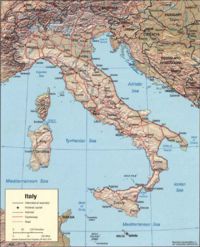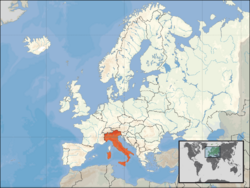| Italian Republic
Repubblica Italiana
|
|
Map of Italy
|
|
Location of Italy on the European continent
|
 |
 |
| Flag |
Emblem |
|
Anthem: "Il Canto degli Italiani"
"The Song of the Italians"
|
| Patron Saint(s): Saint Francis of Assisi |
Capital
(and largest city) |
Rome |
| Official language(s) |
Italian[a] |
| Demonym |
Italian |
| Government |
Unitary parliamentary constitutional republic |
| - |
President |
Giorgio Napolitano |
| - |
Prime Minister |
Mario Monti |
| Legislature |
Parliament |
| - |
Upper house |
Senate of the Republic |
| - |
Lower house |
Chamber of Deputies |
| Formation |
| - |
Unification |
17 March 1861 |
| - |
Republic |
2 June 1946 |
| Area |
| - |
Total |
301,338 km2 (71st)
116,346 sq mi |
| - |
Water (%) |
2.4 |
| Population |
| - |
2011 estimate |
60,813,326 (23rd) |
| - |
2011 (preliminary results) census |
59,570,581 |
| - |
Density |
201.8/km2 (61st)
522.7/sq mi |
| GDP (PPP) |
2011 estimate |
| - |
Total |
$1.847 trillion (10th) |
| - |
Per capita |
$30,464 (30th) |
| GDP (nominal) |
2011 estimate |
| - |
Total |
$2.198 trillion (8th) |
| - |
Per capita |
$36,267 (24th) |
| Gini (2006) |
32 |
| HDI (2011) |
 0.874 (very high) (24th) 0.874 (very high) (24th) |
| Currency |
Euro (€)[b] (EUR) |
| Time zone |
CET (UTC+1) |
| - |
Summer (DST) |
CEST (UTC+2) |
| Drives on the |
Right |
| Internet TLD |
.it[c] |
| Calling code |
39[d] |
a. ^ French is co-official in the Aosta Valley; Slovene is co-official in the province of Trieste and the province of Gorizia; German and Ladin are co-official in the province of South Tyrol.
b. ^ Before 2002, the Italian Lira (₤). The euro is accepted in Campione d'Italia, but the official currency there is the Swiss Franc.
c. ^ The .eu domain is also used, as it is shared with other European Union member states.
d. ^ To call Campione d'Italia, it is necessary to use the Swiss code +41. |
Italy (Italian: Italia), officially the Italian Republic; (Italian: Repubblica Italiana), is a Southern European country located on the Italian Peninsula and the two largest islands in the Mediterranean Sea — Sicily and Sardinia. To the north it is bound by the Alps, where it borders France, Switzerland, Austria and Slovenia. The independent countries of San Marino and the Vatican City are enclaves within Italy, while Campione d'Italia is an Italian exclave in Switzerland. Rome, the capital city of Italy, was for centuries the center of Western civilization and still is today the center of the Roman Catholic Church. It is a member of the European Union. With 60.8 million inhabitants, it is the fifth most populous country in Europe, and the 23rd most populous in the world.
History
Ancient History
Italy's history is perhaps the most important for the cultural and social development of the Mediterranean area as a whole. The country has been host to important human activities in Biblical times, and therefore archaeological sites of note can be found in many regions such as Latium, Tuscany, Umbria and Basilicata.
The first civilization on the Italian peninsula was the Etruscan civilization which began around 800 BC. In the 7th and 8th centuries BC, Greek settlers established many colonies along the southern portion of the Italian peninsula and Sicily. The Romans later referred to this area as Magna Græcia, meaning "Greater Greece." The neighboring islands also came under Roman control by the 3rd century BC. After Magna Græcia, in the 1st century AD, the Roman Empire came to dominate the Mediterranean world for many centuries.
Medieval History
After the collapse of the Roman Empire in the West in the 5th century AD, the peninsula and islands were subjected to a series of invasions, and political unity was lost. Italy became an oft-changing succession of small states, principalities, and kingdoms, which fought among themselves and were subject to ambitions of foreign powers. Popes of Rome ruled central Italy; rivalries between the popes and the Holy Roman Emperors, who claimed Italy as their domain, often made the peninsula a battleground.
Modern History
The commercial prosperity of northern and central Italian cities, beginning in the 11th century, and the influence of the Renaissance mitigated somewhat the effects of these medieval political rivalries. Although Italy declined after the 16th century, the Renaissance had strengthened the idea of a single Italian nationality. By the early 19th century, a nationalist movement developed and led to the reunification of Italy — except for Rome — in the 1860s. In 1861, Victor Emmanuel II of the House of Savoy was proclaimed King of Italy. Rome was incorporated in 1870. From 1870 until 1922, Italy was a constitutional monarchy with a parliament elected under limited suffrage.
The Italy of modern times became a nation-state belatedly — on March 17, 1861 when the states of the peninsula and the Kingdom of the Two Sicilies were united under king Victor Emmanuel II of Italy of the Savoy dynasty, hitherto ruler of Piedmont and kings of Sardinia. The architect of Italian unification, however, was Count Camillo Benso di Cavour, the Chief Minister of Victor Emmanuel.
Rome itself remained for a decade under the Papacy, and became part of the Kingdom of Italy only on September 20, 1870, the final date of Italian unification. The Vatican is now an independent enclave surrounded by Italy, as is San Marino.
The Fascist dictatorship of Benito Mussolini that took over in 1922 led to the alliance with Germany and Japan, and ultimately Italy's defeat in World War II. On June 2, 1946 a referendum on the monarchy resulted in the establishment of the Italian republic, which led to the adoption of a new constitution on January 1, 1948. Members of the royal family were sent into exile because of their association with the Fascist regime, and were only allowed to return to their country in 2002.
Italy was a charter member of NATO and the European Union, and hence joined the growing political and economic unification of Western Europe, including the introduction of the Euro in 1999.
See Also
References
External Links
- General
- Country profiles
- Intelligent Design and Creation
- Government




